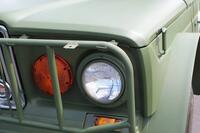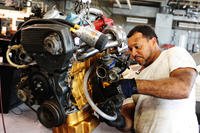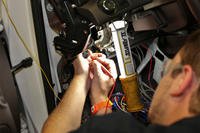by Nigel Evans
Jump Links
- Why You Don’t Need to Go Full Evo
- The Car That Bridged the Gap Between Everyday and Extreme
- A Shared DNA with the Evo X
- How the Ralliart Drove in the Real World
- The Market’s Overlooked Gem
Only a few auto manufacturers have built a truly rock-solid connection between their motorsport successes and mainstream offerings. Of course, you can see examples of road cars that resemble their rally counterparts and attribute their competition success on the weekend to showroom sales on weekdays. However, only a few brands have really nailed this connection. Mitsubishi is arguably among the winners in this particular battle – at least with the Lancer. This company built its legend on the World Rally Championship stage in the 1990s with multiple victories, and its success went on to shape an entire generation of potent performance cars.
Still, some of those evolved performance cars were becoming so complicated and expensive to maintain that the company needed a solution, and this came in the shape of the Mitsubishi Lancer Ralliart. This was a middle-of-the-road choice for a rally-inspired derivative in many respects. Today, it represents the perfect car for those seeking the best of all worlds, as it costs quite a bit less than an Evo X in the marketplace.
Why You Don’t Need to Go Full Evo

Mitsubishi
The turbocharged version of the Mitsubishi Lancer Ralliart was available from the 2009 through 2015 model years. Crucially, it gave people the chance to own a turbocharged, all-wheel-drive model without needing to pay for the cost of buying and maintaining an Evolution X. Certainly, the Lancer Ralliart didn’t wear the full Evo badge. Still, it definitely carried enough of the DNA to give owners a taste of some world-famous rally heritage.
The Lancer Ralliart featured a turbocharged 4B11T engine, active all-wheel drive, a twin-clutch gearbox, and numerous other amenities, offering buyers many of the Evo’s thrills for approximately two-thirds of the cost. Customers got 237 hp and 253 lb-ft of torque, which was quite a bit less than the Evo X's 291 hp. The Ralliart's output was still to reach 60 mph in 5.5 seconds, which was definitely quick enough to worry many other hot hatch drivers of the day.
The Ralliart ran milder boost pressures and had more conventional components than the Evo, resulting in lower maintenance costs and insurance premiums. For those who wanted to unleash their inner Tommi Mäkinen but didn’t want to go all in on a top Evo, the Ralliart produced the grins while remaining a good daily driver. In terms of price, the 2009 Lancer Ralliart was $28,034, whereas the 2010 Evo was $34,310.
Used Car Pricing Comparison
Let’s compare prices for the Lancer Evolution X with the Lancer Ralliart now, looking at unmodified examples from 2011. The auction site Bring a Trailer (BaT) identifies one example of the Evolution X MR (which stands for Mitsubishi Racing) selling for $20,500 in early 2025, with another, which had 29,000 miles on the clock and a GSR (Grand Sport Racing) badge, going for $22,500 in May 2025.
By comparison, another auction site, Cars and Bids, shows one unmodified 2011 Lancer Ralliart selling for $7,700 in 2021 and another — a Sportback version — selling for $7,900 in 2022. This illustrates the pricing differential, albeit with a difference in the sales year.
It’s very tough to find perfectly matched pairs of same-year, same-mileage, same-sales-year cars for a direct comparison. However, Evo X models tend to be routinely in the $20,000-to-$30,000 bracket, according to BaT and Ralliarts, much lower. Even a “nicely” modified, ultra-low mileage 2009 Ralliart on BaT could only reach $17,000 by comparison.
The Car That Bridged The Gap Between Everyday and Extreme

Mitsubishi
To build the Ralliart, Mitsubishi started off with a standard Lancer shell and then picked and chose from the Evo X parts bin. Engineers added mechanical front and rear limited-slip differentials, along with an active center diff to continuously adjust the torque split between the axles. Drivers could then choose between tarmac, gravel, and snow driving modes on some versions, and this type of technology was quite impressive for that era. Visually, the Ralliart was a little bit more subtle than a typical Evo, although it still looked the part. The model had an aluminum vented hood, twin exhaust outlets, aggressive bumpers, and high-performance Yokohama Advan tires. On board, buyers got a Rockford Fosgate sound system, and they could choose Recaro bucket seats to make it more performance-honed than the base model.
A Shared DNA With The Evo X

Mitsubishi
Look underneath the skin, and you’d see that the Ralliart and the Evo X shared a lot of their engineering trickery. Both had the 4B11T aluminum-block turbo engine, although the Ralliart had a lower boost of about 13 PSI, versus around 20 PSI from the Evo. The Ralliart had a similar SST dual-clutch transmission to the Evo MR but without the aggressive S-Sport mode. The torque spread between the front and rear axles was very clever as well, using input from throttle, steering, and yaw sensors. So, when you combine this torque management with the car’s mechanical limited-slip differential, you get plenty of composure from your Ralliart on mixed surfaces to echo Mitsubishi’s rallying expertise.
When it came to stopping your Ralliart, customers got ventilated discs up front with solid rotors at the rear, although the Evo relied on a far meatier Brembo system. Suspension-wise, the Ralliart largely mirrored the basic layout of the Evo, featuring MacPherson struts in the front and a multi-link rear suspension. Still, engineers tuned the suspension differently, using softer spring rates and rubber bushings for the Ralliart versus the solid mounts of the Evo. This tended to make the junior car a little bit more livable for everyday driving.
Read the full article on CarBuzz
This article originally appeared on HotCars and is republished here with permission.










